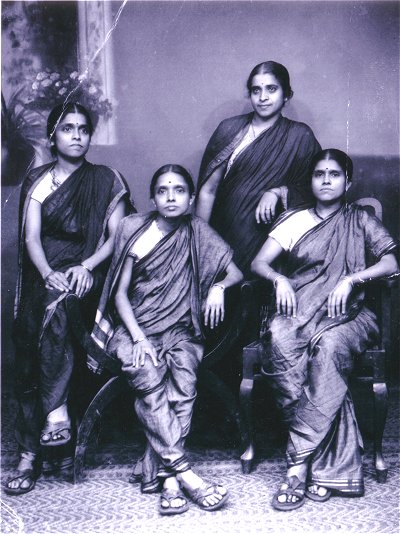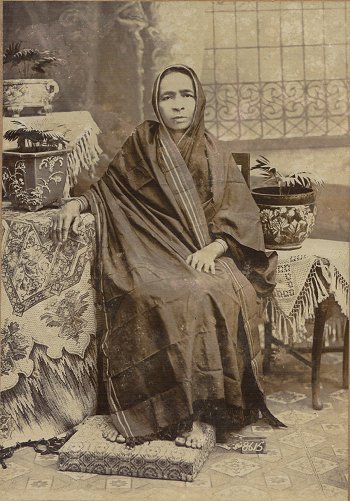Saraswat Women of the Past
by Dr. (Mrs) Jyotsna Kamat
First Online: April 21, 2000
Last Updated: December 07, 2024
As a student of history and of social life in particular, I have read and written about status of women for the last three decades. The position of Saraswat women in the past is a noteworthy one and certainly far better than that of women of rest of India. There are historical and sociological reasons for it.
As an intelligent and industrious community, the Saraswats enjoyed a unique status in ancient and medieval India. They occupied very high posts as commander-in-chiefs, royal Treasurers, defense ministers, ambassadors and interpreters at royal courts of Shilahara, Hoysala, Vijayanagar, Keladi and Sonda Kings. The surnames like Mantri, Bhandari, Dubhashi, Chikkeramane, Prabhu, Shenoy (for Senai -- Senayi) Hegde stand witness to these high posts. Naturally their wives enjoyed equal status of dignitaries and excelled in giving grants to temples and schools, got the village wells dug, tanks constructed and served the entire community in a big way.
Saraswat Ladies as Philanthropists
Earliest mention of a distinguished Saraswat lady , is made in an inscription of 1113 A.D. She got constructed a beautiful temple dedicated to Mahalaxmi at a place called Doddagaddavalli on the Hassan--Belur road. She was Sahajadevi, and wife of Kulhana Ravuta, a big officer of Hoysala kings. They renamed the village as Abhinava Kollapura and gave a grant to Madhava Nayaka of Ravalanatha Halli for arranging special pooja. So Nayaka, is familiar name; Ravalanatha, Mahalaxmi are family deities of Saraswats and this inscription (Epigraphia Carnatica VIII (new) Hassan 40) bears witness that a Saraswat lady along with her spouse, has the unique distinction of constructing the first temple in Hoysala style--among world famous Belur-Halebidu temples, known for their elaborate carvings.
Another famous temple at Mudbhatkal in North Kanara district has the stone images of Kheta Pai and his wife which has unique sculptures all round the outer wall which depict social life of the period. Saraswat women excelled in philanthropic deeds in good number. Nadghar Shanti (saintess, shantibai) and Awadabai were saint devotees of early 19th century who have left devotional compositions in Kannada & Marathi. Shantibai hailed from Mudbhadkal and Awadabai from Mallapur where a "matha" (monastery) constructed by her exists today.
K.L. Kamat/Kamat's Potpourri
Saraswat Women of Yesteryears
Women in traditional nine yard sarees
Education Among Saraswat Women
By and large an enlightened community, the Saraswats had their own system of educating women. It was an domestic system of education wherein, everything to make life worth living was taught like tailoring, management of dairy, grocery, servants & large families. Apart from cooking & other household chores, preparing home medicines occupied an important place. Pangal family of Katpady had some women medical practitioners. One Matti Ganakpati Prabhu who started an Ayurveda pharmacy in 1900 in Mangalore had learnt the Ayurveda system of medicine from his maternal grandmother. Not a small achievement in an age where women were considered ignorant, dependent and hardly better than bonded labor.
But in home medicines women excelled at all times, and each house had a bamboo box which contained roots, leaves and dried fruits which provided instant relief & temporary remedies for all types of ailments from diarrhea to dry cough, from Migraine to Hepatitis. I am told, among the earliest batch of Ayurveda graduates of Karkala Bhuvanendra college were ladies. That speaks of a glorious tradition of women medical practitioners and the priceless value of home medicines in the days when public Medical aid was unknown. My own mother-in-law, Mrs. Ramabai Kamat of Honavar was a popular source of home remedies, and grew many herbs and plants with the sole purpose of public benefit.
kamat.com/Kamat's Potpourri
Radhabai Padmanabh Prabhu
Photograph of circa 1920
Some women were specialized in helping during difficult deliveries and their help was sought by women of all communities. Such noble souls who saved innumerable lives are not remembered because they never sought publicity. They never wanted any returns. They were real servants of society and of God. Name of Kamaladevi Chattopadhyaya nee Dhareshwar is well known. Her grandmother and mother were distinguished in their own way, though it is not that much known. Kamaladevi's Granny could read Sanskrit, Marathi and Kannada and had her own library of religious books. She was a widely traveled lady in those times when bullock carts were the main means of transport. Kamaladevi's mother Girijabai, was in the forefront of women's education and social reforms movement a hundred years ago. She founded Mahila Samaj in Mangalore in 1910 and with the help of Margaret Cousins, was instrumental in bringing in awareness regarding need for women's advancement.
Shri S.S. Talmaki's book on "Konkani Lullabies and Nursery songs" is well known. After painstaking research, he had collected hundreds of proverbs, idioms and riddles, lullabies and nursery songs. It was collected in the early part of this century and published in 1932. Mr. Talmaki collected them from house to house and as ascribed the authorship of several compositions to ladies.
Saraswat community boasts of many first lady doctors, surgeons, entrepreneurs, engineers, governors, principals, professors, educationalist, painters, musicians, dancers, etc. "Kanara Saraswat" used to highlight many achievers from time to time in its monthly report.
Role of women during freedom struggle is too well known. Besides Kamaladevi, Umabai Kundapur Krishnabai Panjikar were frontline leaders for no tax campaign and the Salt Satyagraha and Quit India Movements; every household in Ankola (locate) boasted of women fighters who risked everything for the country. The North Kanara District had the highest number of women freedom fighters in whole of India.
The special status Saraswat women enjoyed in the community provided sound background for women's progress in general after India became free in 1947.
![]()
- Christians of Karavali-Article
- The Coconut Nation!-Article
- Epigraphy to Trace Genealogy-Article
- History of Konkani Language-Article
- Konkani Heritage-Article
- The Antiquity of Konkani Language-Article
- The Millennium Konkani Sammelan - A Report-Article
- The Saga of Swaraswats-Article
- The Women of India - articles and pictures of Indian women
- Biography of Umabai Kundapur

